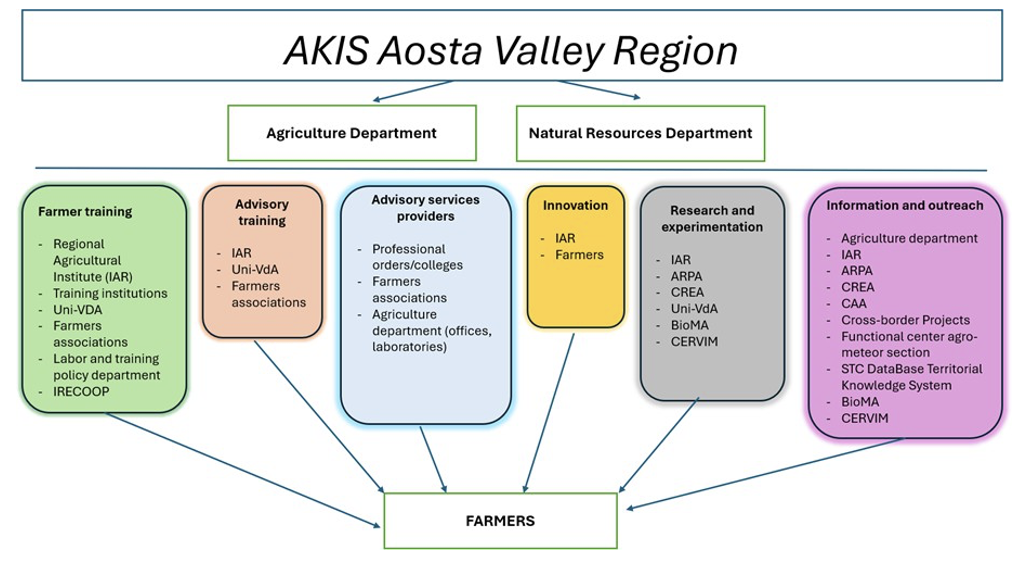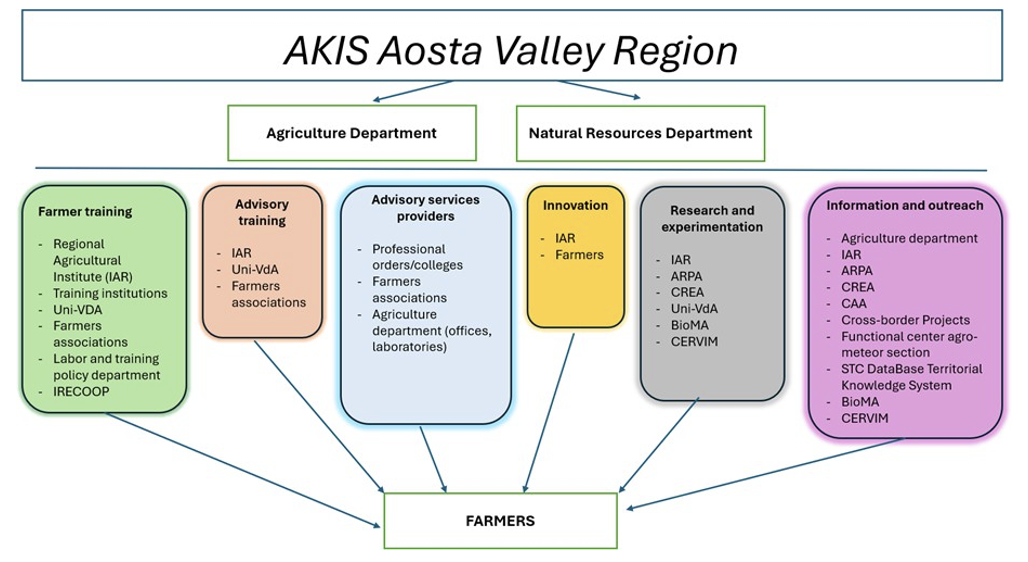2024
AKIS coordination bodies
governance

The AKIS of Aosta Valley Region faces several challenges: a) improving coordination among stakeholders; b) enhancing the dissemination of innovations and support services for farms and rural areas; c) effectively identifying the advisory services, training, and innovation needs of agricultural, agri-food, and forestry enterprises, with particular focus on small and micro-enterprises.
The range of actors involved in training activities at the regional level is broad and highly qualified. In this context, there is a need to coordinate the planning of actions in training, advisory, information, and outreach (including through data and experience sharing and the use of technological and digital innovations).
The AKIS-related interventions activated in Aosta Valley Region within the Rural Development Complementary Programme (RDCP) 2023-2027 include:
The political significance attributed to AKIS strategies within the framework of the 2023-2027 Strategic Plans (SP) of the CAP has highlighted the need to establish governance bodies aimed at coordinating AKIS-related interventions and stakeholders to improve implementation and contribute to the CAP SP’s cross-cutting and specific objectives.
Specifically, the AKIS coordination body is identified by the 2023-2027 SP as the contact point for the European Commission and the European CAP Network.
In Italy, as a result of the new delivery model and unlike previous programming periods, the 2023-2027 CAP SP is established solely at the national level. However, as Regions/Autonomous Provinces hold agricultural competency under the Constitution, they have set up Complementary Rural Development Programs (RDCPs), which, under the CAP SP framework, have their own governance structures and implement rural interventions relevant to their specific territories at the local level.
This programming approach means that Italy includes one AKIS strategy and a CAP SP-level AKIS coordination body (Chapter 8 of the CAP SP; General Directorate of Rural Development of the Ministry of Agricultural Policies, Food Sovereignty, and Forestry) along with regional AKIS strategies and corresponding AKIS coordination bodies for each Region and Autonomous Province.
The general model of AKIS coordination bodies for Italy is indicated by the CAP SP that mentions a mix of "institutions that have the responsibility/capacity to provide training, advisory services, research, information". Lately, in mid-2024, the Ministry of Agriculture established a national AKIS coordination model which calls for a collective body, composed by representatives of the variety of key AKIS actors.
Under this national framework, the Aosta Valley Region established an AKIS Regional Coordination Committee to oversee various AKIS activities. This committee is composed of representatives from all AKIS sectors at the territorial level and is chaired by the “Regional Rural Development Policies” structure of the Agriculture Department, acting as the regional Managing Authority (MA) of the Aosta Valley 2023-2027 RDCP.
1. Who is the AKIS CB
The Regional AKIS Coordination Committee for the 2023-2027 RDCP of the Aosta Valley is a collective body, set up in 2023. The tasks of coordination and technical secretariat will be handled by the MA of the Aosta Valley RDCP 2023- 2027.
2. Composition of the AKIS CB
The regional coordination committee is composed of representatives from institutions and stakeholders who, at the regional level, provide and deliver training, advisory services providers, research, information, digital services, and other activities related to AKIS, tailored to local specificities.
Particularly, it includes (Fig. 1):
1) Representatives of the competent regional authorities and public or publicly significant entities:
2) Representatives of economic and social parties:
Figure 1: AKIS Coordination Body of Aosta Valley RDCP 2023-2027

Source: Our elaborations based on presentation of the AKIS Coordination Committee Aosta Valley - September 25, 2023
3. Functions attributed to the AKIS CB
The committee’s mandate is to coordinate the formulation and implementation of policies for innovation and knowledge within the agricultural, agri-food, and forestry sectors in the region. Additionally, it serves as a liaison on relevant topics with officials of other European funds active in the Aosta Valley, facilitates information flow across regional, national, and European levels, and is represented within the National AKIS Coordination Committee. All stakeholders were actively involved in the establishment of this Regional AKIS Coordination Committee.
4. Procedures for interplaying with other AKIS actors and with the MA of the CAP SP
The AKIS coordination body will convene periodically to ensure effective oversight and monitoring of the AKIS Strategy progress, fostering a collaborative environment for ongoing evaluation and strategic alignment.
The set-up of a collective AKIS coordination body requires: